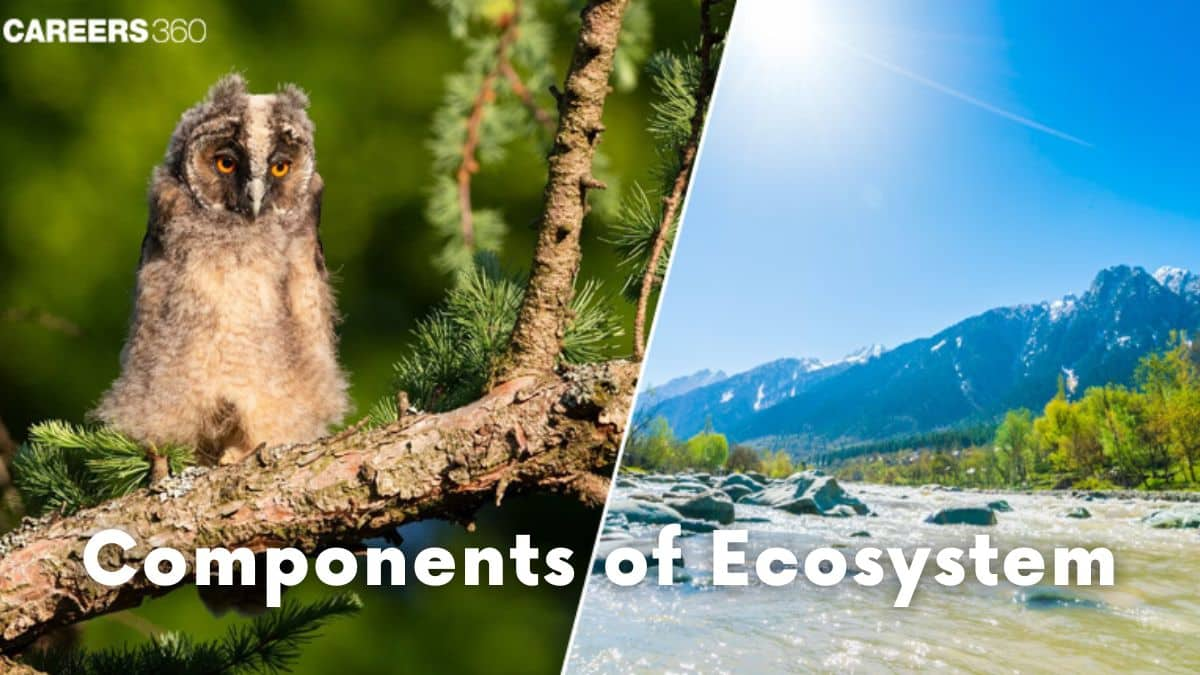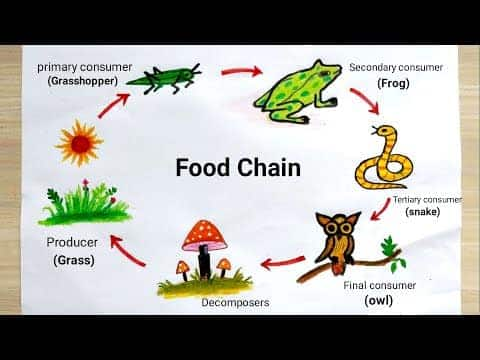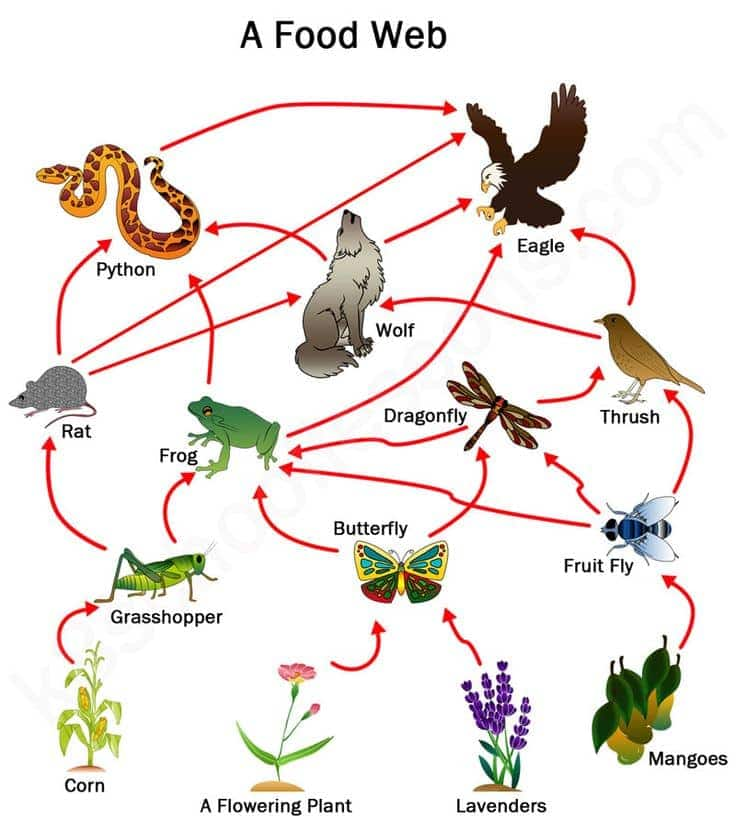Components of Ecosystem: Biotic, Abiotic, Energy Flow, Adaptations & NEET MCQs
An ecosystem consists of biotic (living) and abiotic (non-living) components that interact to sustain life through nutrient cycling and energy flow. Producers, consumers, and decomposers depend on soil, water, air, and climate for survival. Understanding these components is key for Class 12 Biology and NEET ecology.
This Story also Contains
- Definition of An Ecosystem
- Overview Of Biotic And Abiotic Components
- Biotic Components of an Ecosystem
- Abiotic Components of an Ecosystem
- Influence of Abiotic Factors on Biotic Components
- Examples of Adaptation to Abiotic Factors (Xerophytes, Aquatic Animals, Arctic Animals)
- Interdependence of Biotic and Abiotic Components
- Components of Ecosystem NEET MCQs (With Answers & Explanations)

Definition of An Ecosystem
An ecosystem is a biological community of living organisms—the biotic components—interacting with each other and their nonliving environment—the abiotic components. These interactions form a complex network that sustains life through the cycling of nutrients and energy.
The importance of researching ecosystems lies in the understanding of nature's balance, organism interrelation, and changes in the environment affecting them. This knowledge, therefore, becomes extremely useful for the conservation of natural resources, expectations about environmental change, and control of natural resources in an appropriate manner.
Overview Of Biotic And Abiotic Components
Any living creature present in an ecosystem can be thought of as a biotic component. Some of these biotic factors include all living organisms, such as plants, animals, and microorganisms. Abiotic factors refer to non-living components of the environment that directly affect the health of living organisms themselves and, therefore the ecosystem, as a whole. The abiotic factors include components like soil, water, air, and climate. All these elements combine to form a dynamic system in which each constituent has a crucial role to play in maintaining ecological balance.
Biotic Components of an Ecosystem
Biotic components are living things of an ecosystem that involve all organisms living together, interrelating physically with one another, and their non-living environment to support life.
Biotic components are classified as:
Producers (Autotrophs)
Producers, also called autotrophs, are organisms that can synthesise their food with the help of sunlight, photosynthesis, or chemical energy, chemosynthesis. It forms the base of the food chain.
Examples: Plants, algae, and some bacteria.
Consumers (Herbivores, Carnivores, Omnivores)
Primary Consumers (Herbivores): These are organisms that consume producers. Examples include deer, rabbits, and caterpillars belonging to such a group of consumers.
Secondary Consumers (Carnivores): These are customers of the primary consumers. Examples include snakes and foxes.
Tertiary Consumer (Top Carnivores): These are predators that eat the secondary consumers and, of course, are at the top of the food chain. Examples include eagles, lions, and sharks.
Decomposers (Detritivores)
Decomposers break down dead organic material and eventually release the nutrients into the soil, whereupon plants may assimilate them in the form of nutrient uptake.
Examples: Bacteria, fungi, and earthworms.
Interactions Among Biotic Components (Food Chain & Food Web)
A food chain is a single linear sequence that turns on the way energy and essential elements move from one organism to another in an ecosystem.
Producers: These are the base of the food chain, usually plants or algae capable of producing energy by photosynthesis.
Primary Consumers: Herbivores that consume producers.
Secondary Consumers: Carnivores eat primary consumers.
Tertiary Consumers: Higher-level carnivores eating the secondary consumers.
Decomposers: These include bacteria and fungi that break down dead organisms for the recycling of nutrients into the ecosystem.

A food web refers to a complex network of interlinked chains of food in an ecosystem, thus depicting various pathways through which energy and nutrients flow.
Interconnected Chains: A food web contains many chains which overlap and intersect.
Biodiversity: A diversity of feeding relationships and dependencies of organisms on one another.
Stability: This is the capability of the ecosystem to show other feeding alternatives of organisms.
Energy Flow: It provides a much better, and more practical approach to energy flow and nutrient interactions than a simple food chain, which allows various trophic levels and several interactions.

Abiotic Components of an Ecosystem
Abiotic factors include all those non-living elements of an ecosystem. It produces a relationship with living organisms in the ecosystem and comprises factors, both physical and chemical in nature: temperature, light, water, soil, and air.
Temperature
Temperature, precipitation, and humidity are critical factors that determine the types of organisms that can inhabit an ecosystem. For example, as temperature influences metabolic rates, precipitation provides the water necessary for life.
Soil
Soil quality varies according to its content of different minerals, organic matter, and in terms of pH. Nutrients in the soil are really important to the growth of plants, such as nitrogen, phosphorus, and potassium. These same plants ultimately support herbivores and higher trophic levels.
Water
Water is an invaluable resource of life. The amount of water determines the ecosystem, whether it be aquatic or terrestrial. Salinity again determines the types of species that would inhabit the bodies of water, whereas certain species again evolved to inhabit fresh or marine water.
Light
Light is the fundamental source of energy for photosynthetic organisms such as plants and algae, and it is from this light energy that chemical energy is made in photosynthesis.
Air
The composition of air, concerning oxygen, carbon dioxide, and other gasses, supports respiration in animals and photosynthesis in plants. Air pressure and humidity influence weather and living conditions, acting on the control by organisms of body temperature and water balance.
Influence of Abiotic Factors on Biotic Components
Abiotic factors control a lot of the ecosystem, hence setting living conditions on the part of the organisms. For instance, temperature and precipitation patterns define the climatic zones, which in turn determine what amount and kinds of vegetation and animal life exist within them. Soil composition can affect plant health, thereby impacting herbivores and their predators. Water availability is a critical factor both for terrestrial and aquatic ecosystems, controlling which species can thrive in an environment.
Examples of Adaptation to Abiotic Factors (Xerophytes, Aquatic Animals, Arctic Animals)
Abiotic factors have a major impact on growth, reproduction, and survival in ecosystems. Therefore, the living organisms have developed adaptations to survive even in the harshest environments.
Xerophytes: Plants that are adapted to low water availability, mostly with thick, waxy leaves that reduce water loss, deep root systems that help access underground water, and water storage in tissues.
Aquatic Animals: The fish in freshwater have adapted to lesser degrees of salinity, while marine fish are adapted to higher levels of salinity. Some species, such as salmon, adapt to both environments by making appropriate physiological changes.
Arctic Animals: Species such as polar bears and arctic foxes, thanks to thick fur and insulating fat layers, coupled with hibernation or migration behaviours, are adapted to the cold temperatures to survive their harsh winters.
Interdependence of Biotic and Abiotic Components
Nutrient cycles and energy flow reflect the interdependence between biotic and abiotic components in the transfers of basic elements and energy required by life and, hence, maintaining the balance and sustainability of ecosystems.
Nutrient Cycles (Carbon, Nitrogen, Water)
The carbon cycle is the process in which carbon moves through the atmosphere, oceans, soil, and living things. During photosynthesis, plants take in CO₂ and change it into carbon that would be transmitted further along the food chain and reintroduced to the atmosphere through respiration, decomposition, and combustion.
The nitrogen cycle is a process that changes the form of nitrogen. The main processes in the cycle include nitrogen fixation, nitrification, assimilation, ammonification, and denitrification.
The water cycle holds within its paradigm the process of evaporation, condensation, precipitation, and runoff. In simpler terms, the movement of water is continuous within the atmosphere, and land.
Energy Flow and Trophic Levels
Plants, algae, and some bacteria capture solar energy in photosynthesis and store it as chemical energy in the form of glucose. It provides the basic energy source for almost all ecosystems.
Trophic levels refer to steps in a food chain from producers to top predators. Energy does not easily pass from one level within the chain to the next, with approximately only 10 per cent of energy passing to the next level.
Energy Pyramid
An energy pyramid represents the amount of energy at each trophic level and loss of energy at each transfer to another trophic level.
Hence the pyramid is always upward, with a large energy base at the bottom.
Components of Ecosystem NEET MCQs (With Answers & Explanations)
Important topics from the chapter for NEET preparation:
Biotic Factors and its Examples
Abiotic Factors and its Examples
Adaptations to Abiotic Stress (Xerophytes, Aquatic animals, Arctic animals)
Nutrient Cycles (Carbon cycle, Nitrogen cycle)
Ecological Pyramids
Practice Questions for NEET
Q1. Which of the following statements is true regarding the biotic components of an ecosystem?
Biotic components include only the primary producers.
Biotic components include only the top predators.
Biotic components include both the producers and consumers.
Biotic components include only the decomposers.
Correct answer: 3) Biotic components include both the producers and consumers.
Explanation:
Biotic components of an ecosystem refer to the living organisms that make up the ecosystem. These can be classified as primary producers, consumers, or decomposers, and all of these categories fall under the broader category of biotic components.
Producers (autotrophs) are living things that use photosynthesis or chemosynthesis to make their food such as plants, algae, and some bacteria. On the food chain, they are the base.
Heterotrophs, or consumers are living things that get their energy from eating other living things because they are unable to produce their food. Carnivores (secondary and tertiary consumers), herbivores (primary consumers) and omnivores are examples of consumers.
Decomposers: These microorganisms, which include fungi and bacteria, decompose dead organic matter and return nutrients to the environment.
Hence, the correct answer is option 3) Biotic components include both the producers and consumers.
Q2. A much greater proportion of energy fixed by autotrophs is transferred to the herbivore level in the open ocean ecosystem than in a forest ecosystem because
aquatic autotrophs are small.
aquatic herbivores are more efficient feeders.
terrestrial autotrophs are less efficient feeders.
terrestrial autotrophs have more indigestible tissues.
Correct answer: 4) terrestrial autotrophs have more indigestible tissues.
Explanation:
In the open ocean ecosystem, a larger proportion of energy fixed by autotrophs is transferred to the herbivore level compared to a forest ecosystem. This is primarily due to differences in the composition of autotrophs and the digestibility of their tissues.
In the open ocean, autotrophs, such as phytoplankton, are the primary producers. These microscopic organisms are generally smaller in size and have simpler cellular structures compared to terrestrial autotrophs, such as trees in a forest. As a result, a higher proportion of their tissues is readily digestible by herbivores in the open ocean.
On the other hand, terrestrial autotrophs, like trees, often have more complex structures and contain higher amounts of indigestible tissues such as cellulose and lignin. These components are more difficult for herbivores to break down and extract energy from. Consequently, a smaller proportion of the energy fixed by autotrophs in a forest ecosystem is transferred to the herbivore level.
Hence, the correct answer is option 4) terrestrial autotrophs have more indigestible tissues.
Q3. Assertion: Temperature is a limiting factor for the survival of organisms in extreme environments.
Reasoning: Extreme temperatures can denature proteins and disrupt metabolic processes in organisms.
Both assertion and reason are correct. The reason is also the correct explanation for Assertion
Both assertion and reason are correct. The reason is not the correct explanation for Assertion.
The assertion is incorrect, but the reasoning is correct
Both the assertion and reasoning are incorrect
Correct answer: 1) Both assertion and reason are correct. The reason is also the correct explanation for Assertion
Explanation:
Temperature is a limiting factor for the survival of organisms in extreme environments because extreme temperatures can denature proteins and disrupt metabolic processes in organisms. For example, in extreme heat, enzymes can become denatured and lose their function, leading to decreased metabolic rates and potential death of the organism. Similarly, in extreme cold, metabolic processes can slow down to the point where they become insufficient for the survival of the organism. Therefore, both the assertion and reasoning are correct and are related.
Hence, the correct answer is option 1) Both assertion and reason are correct. The reason is also the correct explanation for Assertion.
Also Read:
Frequently Asked Questions (FAQs)
Biotic components include all living organisms like plants, animals, and microorganisms, while abiotic factors or components are nonliving, such as soil, water, climate, and sunlight, which affect these living organisms.
Abiotic factors dictate the kind of organisms that can bear an ecosystem. For instance, the temperature alters metabolic rates while available water determines plant growth and animal distribution.
Decomposers are involved in the breakdown of organic matter from dead organisms to simpler substances that return nutrients—like carbon and nitrogen—into the soil. This is important in nutrient cycling and health maintenance for an ecosystem.
Human activities like pollution, deforestation, and climatic change disturb an ecosystem through habitat alteration, reduction of biodiversity, and compromising its services like clean air and water.
Examples to illustrate this include mutualism—bees and flowers benefit from one another. In commensalism, where barnacles are on whales and do no harm, and in parasitism, the relationship of ticks feed on blood from their hosts. These relationships demonstrate how species depend upon others for survival and reproduction.